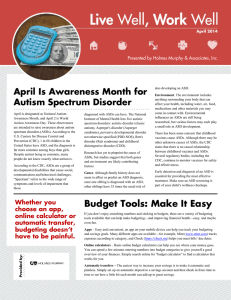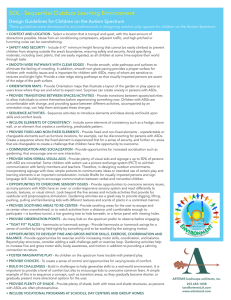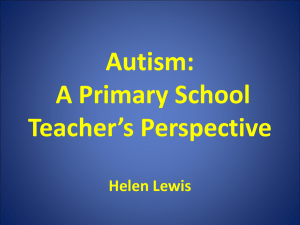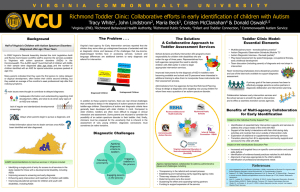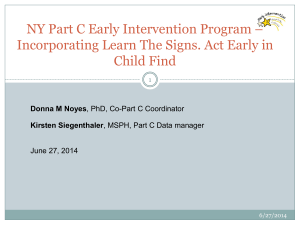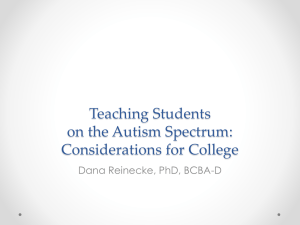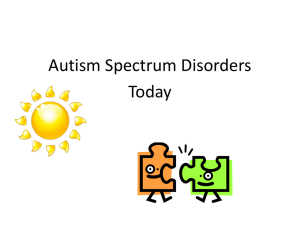The role of attitude in the willingness and effectiveness of teaching
advertisement
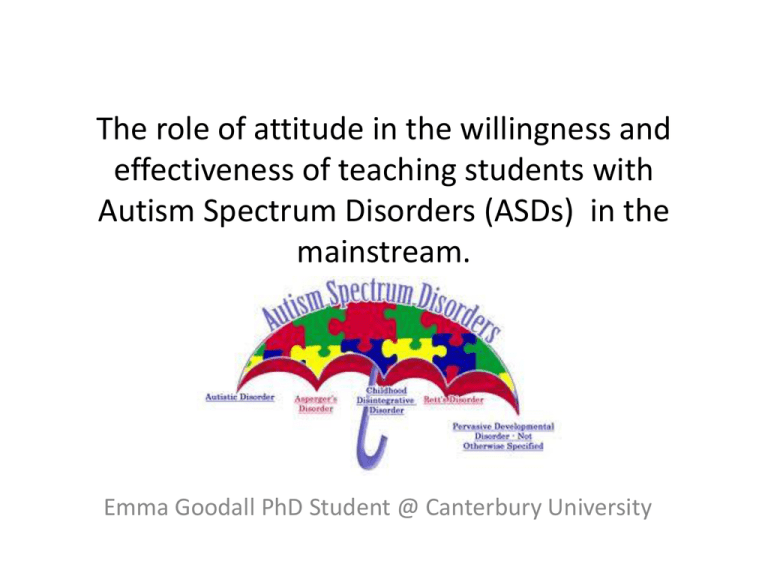
The role of attitude in the willingness and effectiveness of teaching students with Autism Spectrum Disorders (ASDs) in the mainstream. Emma Goodall PhD Student @ Canterbury University Contents The contexts - classroom based research into the reasons why some teachers are more effective at teaching students with Autism Spectrum Disorders (ASDs) in the mainstream than other teachers. - the contexts that teachers are working within Difficulties and opportunities - within classrooms for teachers to meet the needs of their students with ASD. A key finding - a link between attitude, willingness to teach and effectiveness of that teaching. - the effect of teacher attitude towards ASDs and student potential Discussion - possible avenues for mitigating the negative effects of teacher misunderstandings around the potential of students with ASDs as a way forward for teachers to improve their effectiveness Overall Context Classroom Contexts http://whatedsaid.wordpress.com/2010/10/13/just-a-teacher http://nzcurriculum.tki.org.nz/National-Standards/Professional-development http://www.edgazette.govt.nz/articles/Article.aspx?ArticleId=8076 Difficulties and Opportunities • Requirements for school achievement targets (National curriculum equivalents) • Lack of funding for students with verbal skills • Requirements to teach ‘academic curricula’ • Social skills difficulties of many students, not just those with ASDs • Opportunity to develop acceptance and value of difference and individuality Attitude & Willingness – Powerful Drivers of Effectiveness I believe this student can learn and I want to help them achieve their potential Versus I believe this student can learn but I need to share my time equally with all the students in my class Versus I don’t think this student can learn much but I want to help them achieve their potential Versus I don’t think this student can learn much and I can’t see the point in spending so much extra time with them I’m not sure mainstream is the right place for Andrew..... What are the implications around this statement? - when it is said by family/whanau - when it is said by the principal - when it is said by the class teacher Teacher Attitude to Student Potential (ASD vs neurotypical) Mitigating Negative Attitudes When ASD is pathologised as a DIS-ability teacher attitude to student potential is more negative than when ASD is seen as a way of thinking, acting and being differently to the mainstream. If teachers are shown concrete examples of adults with ASD who live full and complete lives they are more likely to accept that all students with ASDs have potential. Temple Grandin, Professor and meat works genius and my heroine. Dan Ackroyd – famous actor. Dr. Michael Burry, founder of the Scion Capital LLC hedge fund, which he ran from 2000 until 2008. Dr. Burry is also chairman of the Pricetector board. (Very rich man, who predicted US financial meltdown!) Understanding leading to appreciation When teachers understand why a student with ASD says and does the things that they are doing they are more likely to appreciate the student’s struggles and gifts. Theoretically understanding the need for structure is not the same as being prepared to provide structure. Understanding the difference structure makes to the emotional, psychological and physical state of a student with ASD should lead to an appreciation of the need to provide structure and hopefully a willingness to do so. ASDs When you have met one person with autism, you have met one person with autism. There is no ‘typical’. Like snowflakes each person with autism is unique. When teachers understand and appreciate that like all people, students with ASD have a range of potential, They can teach to that potential. Thanks to the teachers and students @ Canterbury Primary for being part of my research.
